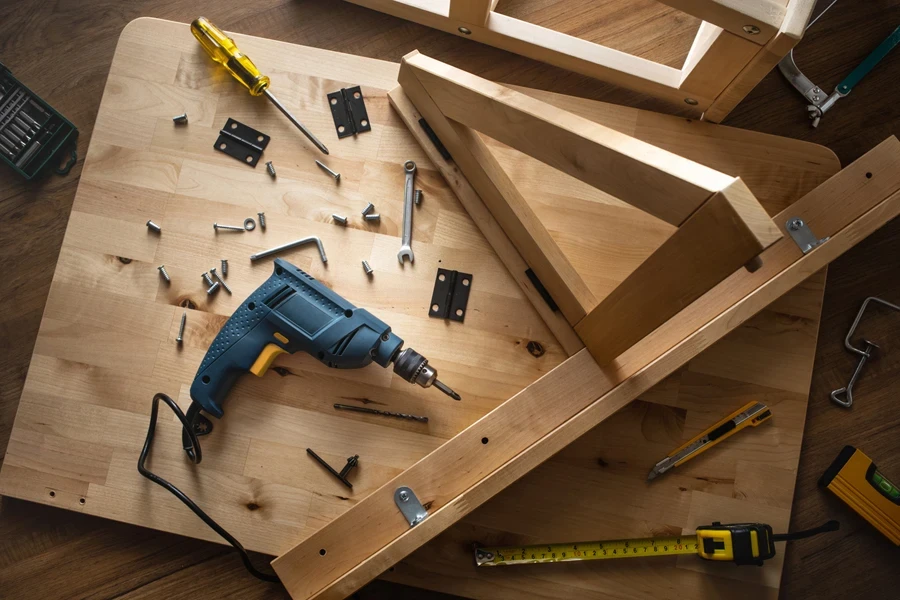Selling furniture isn’t like selling T-shirts or phone cases. Businesses will deal with big-ticket items, hefty shipping costs, and customers who expect quality, style, and durability.
It wasn’t that long ago that people only bought furniture from stores or got them through hand-me-downs. But now, people buy furniture online more than ever, and gone are the days when shoppers needed to test a couch in person before buying. Thanks to better product images, augmented reality tools, and improved return policies, online stores have brought the in-person experience to digital stores.
Buyers now feel confident ordering everything from luxury sofas to handmade dining tables without ever seeing them in person. And with the online furniture industry projected to hit USD 436 billion by 2029, now might be a good time to launch a furniture business, just as long as you understand how to position your products, market effectively, and handle logistics smoothly.
In short, starting a successful furniture business takes planning, investment, and smart decision-making. If you’re serious about turning your idea into reality, following the steps below should provide a stable foundation to get things moving.
Table of Contents
How to sell furniture online in 11 steps
Step 1: Decide what kind of furniture business you want to run
Step 2: Figure out how you’ll fund it
Step 3: Make your business legit
Step 4: Open a business bank account
Step 5: Build a brand that stands out
Step 6: Find the right suppliers (for designers and resellers)
Step 7: Set up your workshop (If making furniture)
Step 8: Manage inventory and storage
Step 9: Learn photography
Step 10: Set up your online store
Step 11: Start marketing
Final thoughts
How to sell furniture online in 11 steps
Step 1: Decide what kind of furniture business you want to run

First, you need to settle on which business model best suits you. The furniture industry is massive, and how you approach it will determine everything from your costs to your marketing strategy.
You may be a business owner who is also a maker, meaning you’ll be wanting to build your furniture and sell it directly. You may also be a curator, reselling pieces from manufacturers or wholesalers. Finally, dropshippers sell furniture online without ever handling inventory.
These are the main models most sellers will fall into:
- Make and sell your furniture: Woodworkers or designers, these owners create custom, handcrafted pieces with premium pricing. However, the downside is that this business model can take time to scale.
- Curate and resell: New businesses will buy furniture from manufacturers and wholesalers and then sell it at a markup. While this model is faster to start, owners will need solid supplier relationships for the best deals.
- Dropshipping: This model doesn’t require an inventory or warehouse. Businesses can work with the supplier to ship directly to customers. It may sound easy, but the brand forfeits control over quality and delivery times.
- Upcycled and refurbished furniture: Finding, restoring, and selling vintage or secondhand furniture is also a great business. However, this growing niche requires significant hands-on work.
- Furniture designer: Can’t build the furniture? Consider designing it instead before having them made.
New furniture entrepreneurs should pick a model that matches their skills, budget, and vision. Be aware that once you start, switching paths can be quite complicated.
Step 2: Figure out how you’ll fund it
Let’s talk money. Launching a furniture business isn’t cheap, unless you choose a dropshipping or small-scale refurbishing model. Here’s a look at two ways you can fund your furniture dreams:
On the low end
By choosing dropshipping, it’s conceivable that you’ll be able to start your furniture business with only a few hundred dollars as you won’t need to keep inventory. Costs will also remain low if you’re dealing with custom or made-to-order furniture via a workshop. This model allows you to buy materials when needed without spending much upfront.
On the higher end
Don’t have the tools and equipment to start a furniture-making business? Setting up a workshop can be expensive (think thousands of dollars), and you must also consider other expenses, such as rent, safety gear, and utilities. Even starting a resale business can be expensive, as you’ll need to create an inventory before making sales.
Some other ways to secure funds include:
- Crowdfunding
- Funding from potential customers
- Bank loans
- Small business grants
- Venture capital firms
Step 3: Make your business legit

Nobody likes paperwork, but it’s all a major and important part of starting a business. A proper business structure protects you from legal trouble and tax headaches. Here’s what new businesses should do to cover all their legal requirements:
- Register your business and choose an LLC for liability protection. You can also register as corporations and sole proprietorships (the most common business type).
- Get an employer identification number (EIN) – your business’s tax ID
- Apply for necessary permits and licenses, and keep in mind some states require resale permits or sales tax licenses
It may be boring, but getting this part out of the way early makes everything easier down the road.
Step 4: Open a business bank account
Mixing personal and business finances is a nightmare – just don’t do it. Instead, create a business bank account to keep things clean, make tax filing easier, and build credibility. While at it, consider getting the following:
- A business credit card for expenses.
- Accounting software to track expenditures
Step 5: Build a brand that stands out

The furniture market is highly competitive, and if you don’t have a clear brand identity, your business is bound to get lost in the noise. This is where entrepreneurs should think about defining their brand’s story, aesthetic, mission, and target audience. Once you decide whether to make or resell furniture, the next thing to do is to refine your niche.
Will your business specialize in sofas, minimalist pieces, homes, offices, or other types of furniture? Also, consider the target category (office, home, or outdoor), style (modern or rustic), target customers, pricing strategy, and niche trends. Your branding process should also include market research, identifying customer preferences, analyzing competitors, and following trends.
Once you’ve identified your niche, document your brand’s identity, mission, and values. With a solid brand foundation, it’s then time to design your collections, set up a website, etc., and attract potential buyers.
Step 6: Find the right suppliers (for designers and resellers)
If you’re not building the furniture, you need good suppliers. Here’s what designers, resellers, and other business modes should consider when sourcing furniture:
Designers
If you don’t want to build the furniture, find a manufacturer to help bring your designs to life. However, only work with manufacturers that involve you in the process and work with you as a partner. This way, you can ensure everything meets your standards.
Resellers
As a reseller, you can source your inventory by reaching out to brands and makers, inquiring about wholesale prices and terms. Alternatively, check out wholesale marketplaces, where vendors actively look for retail partners to work with.
Vintage sellers
Vintage furniture sellers will need to hunt for their inventory – here are some great places they can start:
- Auction houses (whether in-person or online on auction sites like eBay and MaxSold)
- Estate sales
- Online marketplaces (focus on sites like Craigslist and Facebook Marketplace and listings for yard, moving, or estate sales)
- Flea or outdoor markets
- Private collectors
Dropshippers
Furniture dropshippers have many options, including choosing suppliers from directories like AliExpress. Entrepreneurs can also work with a few furniture brands if they set their dropshipping terms individually.
Step 7: Set up your workshop (if making furniture)

If your business involves handcrafting pieces, the workspace will need to be efficient. Although it can be expensive (especially if owners don’t have the required equipment already), furniture brands must consider the following when setting up their workshops:
- High-quality tools (don’t skimp on tools to avoid inconsistent products)
- A functional and tidy layout (the more organized the workspace, the faster makers can produce pieces)
- Pricing strategy (always factor in the materials, labor, and time into the furniture’s prices)
Step 8: Manage inventory and storage
If the plan is making or reselling furniture (without dropshipping or custom orders), you’ll need to consider how much storage you’ll need to store their inventory. As mentioned earlier, this part often contributes to the huge startup costs. Here are some storage options to consider:
- Rent a climate-controlled space to keep overflowing inventory
- Work with a warehouse partner that can even handle order fulfillment and shipping
- Rent/buy a dedicated office and warehouse space
- Set up a free room for storage at home
Step 9: Learn photography

Since online shoppers won’t be able to touch your items or see them in person, you must make the shopping experience as realistic as possible. That means capturing size, texture, and details in high-quality photos, allowing consumers to picture the furniture in their home before buying.
Step 10: Set up your online store
Now that new owners have covered all the basics, it’s time to experiment with an online store builder. Start by launching a simple landing page – this is a great way to build hype and create an email list for a successful launch. Even if you don’t have design skills, online store builders (like Shopify) make the process easy and accessible. Otherwise, consider hiring a designer to capture your brand.
Before launching the online store, ensure all essential pages, including About Us, Contact, and FAQs, are ready. Small, story-driven brands usually enjoy a competitive edge over larger retailers. Additionally, ensure the shipping and return policies are clear enough to avoid certain problems with furniture logistics.
Step 11: Start marketing
Launching a website successfully is just one part of the pie. New furniture businesses must also market brands. However, remember that people have different tastes, and while some consumers may want minimalistic furniture, others may only need help with design ideas.
That’s where content can make a big difference. Consider growing an audience on social media platforms, especially Instagram, YouTube, or TikTok (the best places for visual content). But don’t always push for sales – instead, share home design tips and advice. This is one of the best ways to offer value while funneling more traffic to your online store. Plus, businesses with a reputation as trusted experts have higher chances of making sales.
Final thoughts
Making or reselling furniture online can be profitable, especially for creative-minded people. But it’s not easy. Such a venture can get expensive if entrepreneurs don’t have a workshop and furniture-making tools. But if they don’t mind the high upfront costs, follow the steps above to stand a better chance at successfully selling furniture at a fair price online.
Finally, remember that buying business insurance is never a bad move when selling online, and while you’re at it, research what legal experts advise in terms of purchasing additional protections. It’s important that you protect yourself from loss (such as items being damaged during delivery) and protect your customers’ orders via warranties.




